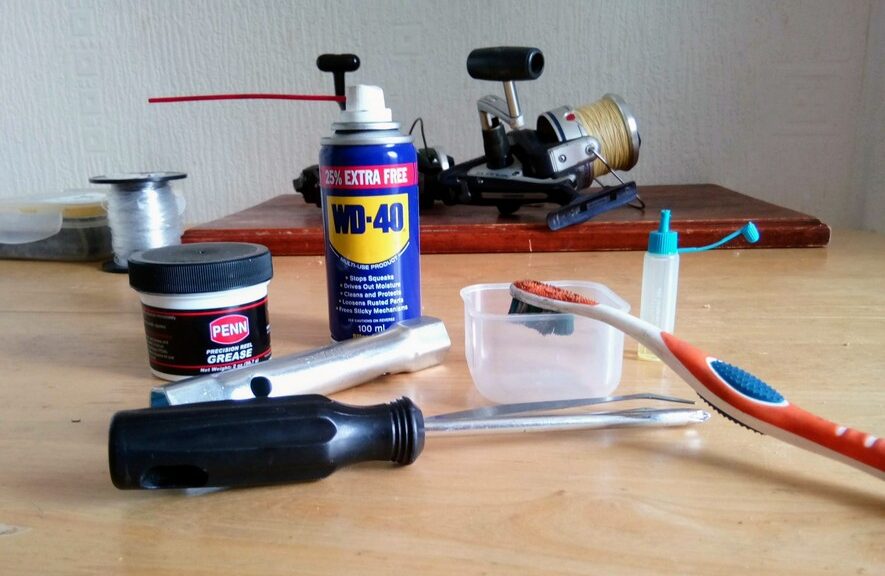
5 things to do when you can’t go fishing
There are times when you can’t go fishing. At the moment a horrible virus has brought big parts of the world to a standstill. But even in normal times there might be reasons why you can’t go fishing (bad weather/ neglected spouse/ broken car). Here’s 5 things you can do that will make your life a lot easier when you can go fishing again.
1. Make new fishing rigs
Nothing is worse than running out of rigs when the fish are on the feed. There’s a good chance that once you’re done tying a new rig all the action is over. Whatever type of fishing you do, you can never have enough rigs (in my opinion at least).
It’s always a good idea to check your rigs at home in daylight. A frayed rig could lose you the fish of a lifetime and blunt hooks will make it very hard to catch anything. Don’t forget to check the line on your spool too, and remove any line that’s damaged.
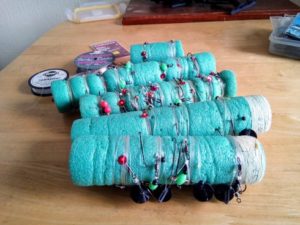
Days when you can’t go fishing are also good for tying rigs you haven’t tried before. If you don’t mind being ridiculed by the rest of your household, you can imagine your hand is a fish to test out how these rigs work (after nearly a month of lockdown, that’s where I’m at anyway). For some easy sea fishing rigs, check this blog post.
For lure fanatics this is the time to repair your favourite plugs and spinners, and change those rusty treble hooks for shiny new ones. And if you’re a fly fisherman and tie your own flies, I envy you, cause you never run out of things to try.
2. Service your reels
Losing a fish because of a damaged rig hurts, but losing a fish because of a malfunctioning reel hurts even more. And besides that, unless you carry a spare reel with you, that probably means the end of your fishing session.
Besides the occasional drop of oil (line rollers, handle, shaft) a reel needs to be serviced regularly to make sure it performs smoothly. How often depends on how often you go fishing. As I fish quite a lot and mostly in salt water I service my reels at least once a year. As grease disappears and sand and dirt makes its way in, reel components will start to wear out. To prevent this, reel parts need to be removed, cleaned and greased, and reassembled. I own reels that have been heavily used for over twenty years and still perform well.
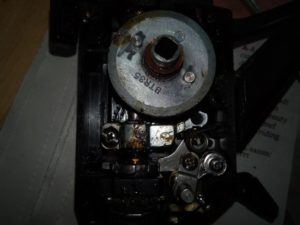
How to disassemble a reel depends on the type and brand. Before doing anything it’s always a good idea to check if there’s a tutorial out there. And if you don’t feel comfortable servicing your reel you can always send it to a professional. In the UK, I can recommend Felindre Innovations. It just means you will have to find something else to do when you can’t go fishing.
Reel maintenance tips
Use the right tools
Whatever type of reel you’re servicing, make sure you use the right tools. The wrong size or type of screwdriver can result in stripped screws or worse. Before you start on a project make sure you have all the tools you need. Although it might not be strictly essential, a pair of tweezers always comes in handy, especially if you have big fingers. Spark plugs spanners can come in handy to remove rotor nuts.
Take pictures
Take pictures of every step you take, to make sure you know what goes where once it comes to reassembly. Organise screws and parts in separate containers to limit confusion and make sure nothing rolls on the floor… This is true for all DIY projects, by the way. Like a lot of things, I learned this the hard way. Exploded diagrams are handy too. These are often printed on the box the reel came in. If you don’t have that box any more you can probably find it on the internet.
Oil and grease
WD-40 is great for degreasing and cleaning parts, but it’s not a very good lubricant. Spraying WD-40 into the guts of your reel will do more harm than good, as it will remove all the grease, and spread the sand around. Best is to spray some into a separate container and dip the part you want to clean into that. Apply grease once the part is clean and dry.
As a general rule, use grease where there is metal on metal contact (like gears), and oil on other parts (like the line roller for instance). There are loads of different lubricants out there, but the ones I use are Penn precision reel grease and Shimano bantam oil. If you don’t want to spend anything on a specific fishing reel grease, lithium grease will probably do. If you can avoid it, don’t use anything from an aerosol can.
Be aware of left hand threaded rotor nuts
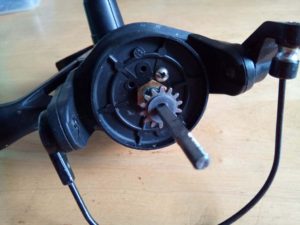
Some rotor nuts have a left hand thread, therefore are loosened clockwise and tightened anti-clockwise. Most of the time left-hand threaded nuts have grooves on the outside. So before you apply a lot of force, make sure you’re turning it in the right direction. Normal threaded nuts often have a small screw next to it to keep them in place.
3. Repair your rods
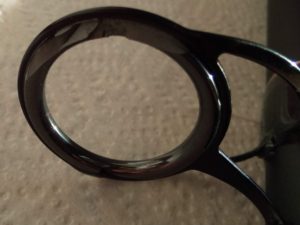
Another thing to do when you can’t go fishing is rod repair. As long as you don’t step on them (been there) or close the car door with the tip sticking out (done that) rod blanks can take quite a bit of abuse. Rod guides are a different matter however. It doesn’t take much for ceramic inserts to break or pop out. Broken inserts might not always be so obvious, but can result in sudden snap off’s while casting or fighting a fish. So it’s a good idea to check your rod guides regularly, especially after you dropped your rod on the rocks.
Tip guides
Tip guides are the easiest to replace. Carefully apply a bit of heat with a lighter to melt the glue underneath and pull the broken guide off. Measure the guide and order like for like. Once your tip eye, apply some hot melt glue to the rod tip, slide on the the eye and line it up with the other guides.
Whipping rod guides
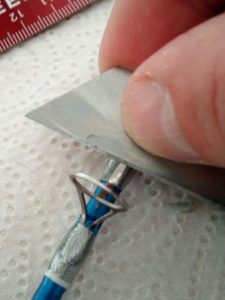
Whipped rod guides take a bit more time to replace. A bit of heat helps here to, but be very careful if you use a lighter as it might damage the blank. A heat gun or hair dryer is probably a safer option. Then use a utility knife blade to remove the whipping. Cut the whipping where it covers the foot of the guide, not over the blank. Then you can simply peel the whipping of by hand. Scrape all the remaining glue off with your thumbnail or a hard plastic card, applying a little bit of heat if necessary. Once you removed all the residue, you can whip the new guide on. I found this tutorial on whipping guides very useful. And this is the kit I used to whip the new guides with.
Clean your rods
Days that you can’t go fishing are also good for cleaning your rods. Remove sand and dirt from your reel seats. Wipe your rods down. A bit of WD-40 on a cloth can help to remove light rust from your guides.
4. Look for new fishing marks
Days that you can’t go fishing are also good for looking for new marks. When you don’t have enough time to go fishing but still able to go out, why don’t you check out that mark you were always wondering about and take a few pictures. Even if you do have the time to go fishing it’s not a bad idea to leave the rods at home when exploring new marks. Sit down, observe. If you’re a sea angler, low tide is the best time to do this. Note where the snags are, and pay particular attention to gulleys, holes and other potential fish holding areas. For carp anglers, find yourself a good sheltered lookout (like a tree) and observe how the fish move through the area, where they feed, etc.
Being stuck in the house shouldn’t stop you from looking for new mark either. Google earth can expose a lot more information you wouldn’t be able to see from the shore. Time doing research is never wasted, it will definitely improve your results.
5. Earn your brownie points
Days when you can’t go fishing are great for earning browning points. Cook a nice dinner, fix the fence. Make sure they think fondly of you before you disappear for days on end again…
What do you do when you can’t go fishing? Please share your tips in the comment section below!
And if you’d like to receive an email every time I publish a new post, please subscribe to my newsletter. Tight lines!
Disclosure: if you purchase anything using the links in this blog post, I might make a commission. Affiliate programs and affiliations include, but are not limited to, the eBay Partner Network. It doesn’t cost you a penny more to buy via these affiliate links (and you don’t have to use them of course) but it helps me to keep this blog going. Thanks!
2 thoughts on “5 things to do when you can’t go fishing”
Great to meet you on the beach at St Cyrus the other day. Voluntarily doing the housework, vacuuming, dusting etc is my brownie point earner along with cooking nice meals! Thanks for the tips.
Tony
Thanks for your comment, Tony. Yes, earning the brownie points are an often neglected part of the angling life! I wrote a post on fishing for flounder that might be useful. Probably see you again on the beach someday.
Cheers, Bas